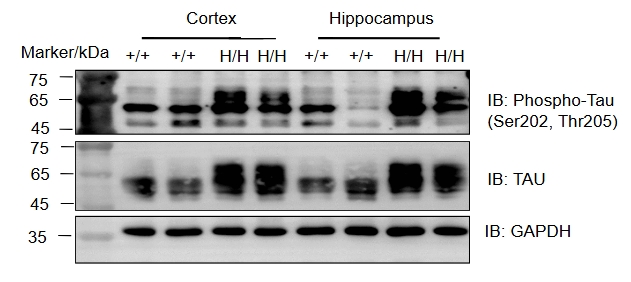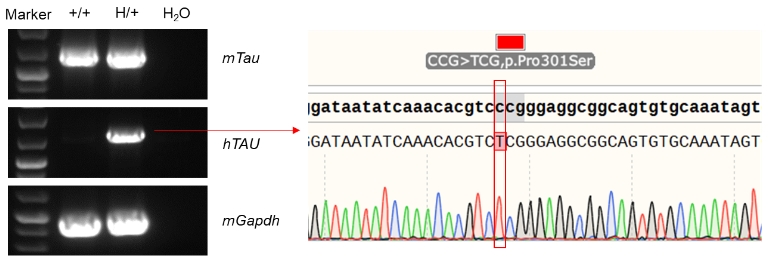


C57BL/6JNifdc-Igs2tm1(Prnp-MAPT*P301S)Bcgen/Bcgen • 112927
| Product name | B-hTAU*P301S mice |
|---|---|
| Catalog number | 112927 |
| Strain name | C57BL/6JNifdc-Igs2tm1(Prnp-MAPT*P301S)Bcgen/Bcgen |
| Strain background | C57BL/6JNifdc |
| NCBI gene ID | 17762 (Human) |
| Aliases | Tau, Mtapt, PHF-tau |
| Application | This product is used for pharmacodynamics evaluation of Alzheimer's disease (AD). |
Gene targeting strategy for B-hTAU*P301S mice. The full coding sequences of human TAU gene with P301S mutation that is driven by mouse Prnp promoter are inserted into mouse Hipp11 (H11) locus in B-hTAU*P301S mice.

Western blot analysis of phosphorylation of TAU protein expression in homozygous B-hTAU*P301S mice. Cortex and hippocampus lysates were collected from wild-type C57BL/6J mice (+/+) and homozygous B-hTAU*P301S mice (H/H, 12-week-old mice, n=2), and then analyzed by western blot (Phospho-Tau (Ser202, Thr205) antibody: Invitrogen, MN1020; anti-TAU antibody: CST, #46687). 20 μg total proteins were loaded for western blotting analysis. TAU and p-tau were detected in cortex and hippocampus of both wild-type and homozygous mice.

Strain specific analysis of TAU mRNA expression in wild-type C57BL/6 mice and heterozygous B-hTAU*P301S mice by RT-PCR. Brain RNA were isolated from wild-type C57BL/6 mice (+/+) and heterozygous B-hTAU*P301S mice (H/+), and then cDNA libraries were synthesized by reverse transcription, followed by PCR with mouse or human TAU primers. As control, a group without reverse enzyme was also set. Mouse TAU mRNA was detectable both in wild-type C57BL/6 and heterozygous mice. Human TAU mRNA was detectable only in heterozygous B-hTAU*P301S mice but not in wild-type mice.